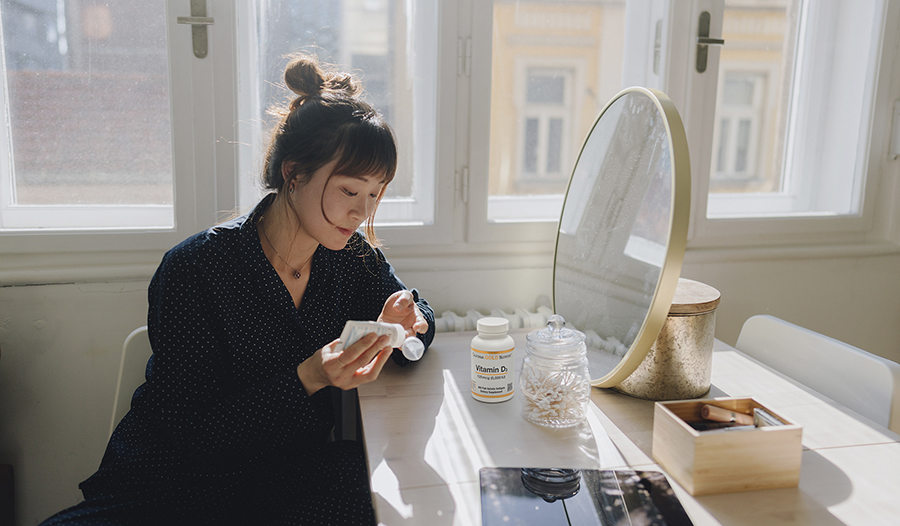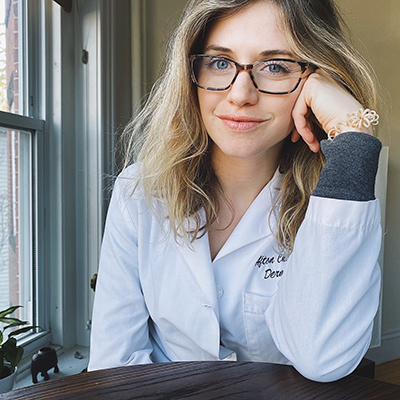Защо дерматологът дава предимство на съня, здравословната диета, витамин D и ежедневните физически упражнения

Всички ние просто правим най-доброто, на което сме способни.
Много от нас се стремят да подобрят навиците и поведението си, за да оптимизират здравословното си състояние. Лично аз почти всеки ден мисля за това какво трябва да направя, за да се превърна в най-здравата и най-щастливата версия на себе си. Тази нагласа обикновено се засилва по време на преходни периоди - на нова година, на рожден ден, след смяна на работата или местоположението.
Тези моменти на преоценка на целите и напредъка ни са от решаващо значение за стимулиране на растежа и промяната в нас самите. С течение на годините създадох няколко уелнес навика, които усъвършенствах, промених, провалих и успях. Така че, ако сте в застой или ако просто правите някои промени в начина си на живот, прочетете нататък.
Сън, упражненията, диетата и витамин D са някои от ключовите съставки в моята лична програма за добро здраве. Това може да звучи очевидно, но ще опиша подробно как подхождам към всяко съображение - и тъй като това е дерматологичен блог, ще се съсредоточа върху обяснението как всяко от тези поведения влияе върху здравето на кожата ни.
Сън
Първият компонент на моя уелнес режим е сънят. Опитвам се да си лягам около 21:30 ч. и да се събуждам около 5:30 ч. всеки ден.
Здравословният сън, който ви помага да изглеждате, да се чувствате и да работите по най-добрия начин, не е свързан само с броя часове дълбок сън, а и с редовността на цикъла сън-бодърстване. Последователността в това кога си лягате и кога се събуждате може да помогне на тялото ви да установи нормален циркаден ритъм и да оптимизира колебанията на кортизола в организма през деня.
Липсата на сън се отразява на кожата ви
Липсата на сън може да допринесе за "провъзпалително" състояние, което може да влоши сърбежа и възпалителните състояния на кожата като псориазис. Както може би сте забелязали, недостигът на сън може да се прояви в кожата на лицето като тъмни кръгове под очите, увиснали, подути клепачи и присвити ъгли на устата. Едно проучване дори показва, че лошото качество на съня е свързано с намалена бариерна функция на кожата и повишена трансепидермална загуба на вода (загуба на способността на кожата да се хидратира).
Моите навици за здравословен сън
Когато имам проблеми със заспиването и установяването на режим на сън, приемам добавка с мелатонин (не по-късно от 20:00 ч.), за да ми помогне да заспя и да установя цикъла си на сън.
Всяка вечер използвам тапи за уши, за да не преработва мозъкът ми подсъзнателно всички малки звуци, които се чуват през нощта, и нося маска за очи за сън. Освен това се опитвам да спя на различни страни на тялото си - лежането само на една страна може да доведе до повече бръчки и загуба на подкожна тъкан от страната на лицето, на която спите.
Упражнение
Една от най-важните части на деня ми са упражненията. Целта ми всяка седмица е да правя някаква форма на упражнения всеки ден от седмицата, но понякога животът ми пречи и може да успея само четири или пет дни.
В някои дни правя йога, а в други - баре, тичам, посещавам виртуален фитнес клас или карам ски, в зависимост от сезона. Важното е, че се опитвам да се занимавам с някаква форма на движение, която ми доставя удоволствие.
Упражненията подобряват състоянието на кожата ви
Упражненията засилват притока на кръв в цялото тяло, включително и в кожата. В резултат на това той може да окаже благоприятно въздействие върху заздравяването на раните. Освен това може да подобри настроението и самочувствието ви, което е важна част от цялостния "пакет", освен просто сияйната кожа.
Често включвам електролитни смеси във водата си преди или след тренировка, за да остана добре хидратиран. Поддържането на добра хидратация може да спомогне за изпъване на кожата и намаляване на фините бръчки.
Диета
Диетата е следващата ключова стъпка в моята рутинна програма за здравословно състояние на кожата. Спазвам предимно растителна диета, като от време на време добавям пилешко месо и морски дарове. , подобно на средиземноморската диета. Всеки ден пия по чаша кафе и няколко дни в седмицата се наслаждавам на чаша червено вино. Опитвам се да избягвам преработените храни, сладките храни с висок гликемичен индекс и червеното месо.
Как диетата влияе на кожата ви
Изследванията показват, че тези хранителни практики могат да подобрят дълголетието и да помогнат за намаляване на възпаленията в организма - така че вероятността да допринесат за кожни заболявания и стареене е по-малка. Данните сочат и връзка между млечните продукти (особено обезмасленото мляко) и високогликемичните храни и акнето.
Хранителното начало води до по-здравословен ден
Обикновено започвам сутрините си с растителен протеинов шейк, който е пълен с витамини и антиоксиданти , за да се храня максимално добре, особено когато тренирам много. Все още не е ясно дали витаминните добавки и оралните антиоксиданти наистина имат значение, или просто се разграждат в червата, но аз обичам да ги използвам, защото ме карат да се чувствам по-здрава, което ме кара да правя други здравословни избори през деня.
Витамин D
Като дерматолог аз съм религиозна в нанасянето на слънцезащитни продукти. Използвам овлажняващ крем с SPF . 30 или по-висок върху лицето и шията си всяка сутрин. Ако ще бъда навън, нося шапки, слънчеви очила, слънцезащитен крем за тяло или дрехи с дълги ръкави.
Тъй като много внимавам със защитата си от слънцето, а през зимата съм толкова покрита, може би съм изложена на по-висок риск от недостиг на витамин D. Това е така, защото въпреки че част от витамин D в тялото ни идва от храната, голяма част от витамин D се синтезира в кожата в отговор на ултравиолетовите лъчи при излагане на слънце.
Някои характеристики ви излагат на по-висок риск от недостиг на витамин D:
- По-тъмна кожа: Естественият пигмент меланин в по-тъмната кожа блокира ултравиолетовата светлина.
- Малабсорбционни нарушения: Тъй като витамин D е мастноразтворим, хората, които не могат да усвояват добре мазнините, също имат намалено усвояване на витамин D.
- Някои лекарства: Някои лекарства могат да повлияят на синтеза или разграждането на витамин D.
- Живот по-далеч от екватора: Слънцето е по-ниско в небето на високи и ниски географски ширини, което води до по-ниски нива на UV лъчите.
- По-възрастна възраст: С напредването на възрастта организмът ни може да стане по-малко ефективен при производството на витамин D от излагането на слънце.
Пациентите ми често ми казват неща като: "Докторе, имам нужда от витамин D, затова обичам да се пека на слънце" или "Не нося слънцезащитни продукти, защото се притеснявам от недостиг на витамин D". Моят отговор е, че в действителност са ви необходими само около 15 минути слънчева светлина на ден, за да си набавите необходимия витамин D.
Добавки с витамин D - по-безопасно от слънцето
Ако все още се притеснявате за състоянието си на витамин D, помислете за добавки с витамин D . Още по-добре е да поискате от лекаря си да провери нивото на витамин D, за да видите дали действително имате недостиг, след което да получите професионална препоръка за дозата, от която се нуждаете, за да го набавите.
Понастоящем има доста спорове относно това какво е подходящото "нормално" ниво на витамин D. Но ето какво знаем - UV радиацията от слънцето е канцерогенна, така че хранителните добавки са по-безопасен начин за получаване на витамин D, отколкото от слънцето. Ето защо, освен обичайната ежедневна защита от слънцето, редовно добавям витамин D като част от моята профилактика.
Вземане на храна
И така, ето го. Ключовите части на моята дерматологична уелнес програма са сънят, упражненията, диетата и витамин D. Всяка от тях е от решаващо значение не само за това как се чувствам, но и за здравето на кожата ми. Обмислете дали да дадете приоритет на тези прости, но дълбоки поведения, докато проучвате и подобрявате собственото си пътуване към уелнес!
ОТКАЗ ОТ ОТГОВОРНОСТ:Този УЕЛНЕС ХЪБ няма за цел да поставя диагнози...














































































 Съдържание
Съдържание


